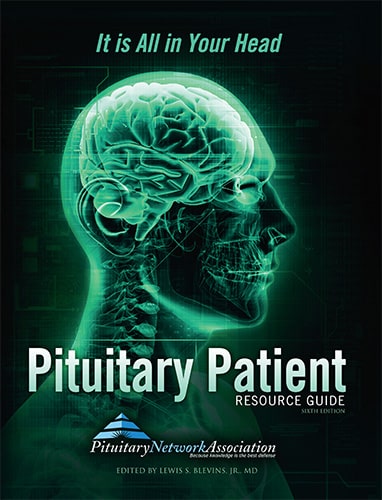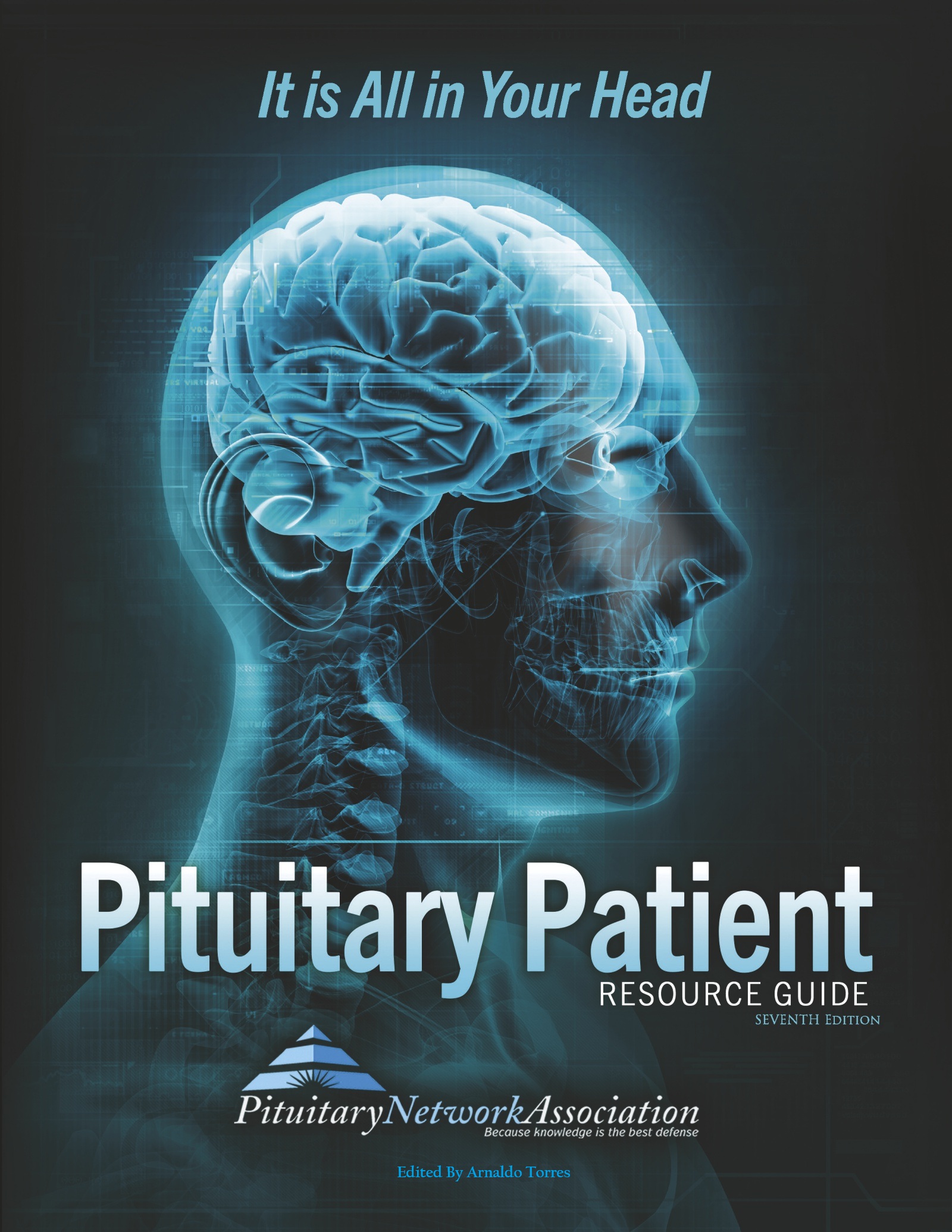News Articles February 2022
Written on 04 February 2022.
PNA Medical Corner: When Pituitary Carcinoma Spreads to the Cervical Spine
This month the PNA Medical Corner focuses on a study co-authored by longtime PNA member Dr. William Couldwell. It presents a case study of a woman whose prior pituitary carcinoma spread to the cervical spine. They conclude that long term monitoring of hormones after pituitary surgery is crucial.
Link:
Natural history of pituitary carcinoma with metastasis to the cervical spine: illustrative case
Nicholas T Gamboa, Christopher Wilkerson, Bornali Kundu, Brandon A Sherrod, Andrew T Dailey, William T Couldwell
- PMID: 36647250 PMCID: PMC9844525 DOI: 3171/CASE22363
Free PMC article
Abstract
Background: Pituitary carcinoma is a rare tumor of the adenohypophysis with noncontiguous craniospinal dissemination and/or systemic metastases. Given the rarity of this malignancy, there is limited knowledge and consensus regarding its natural history, prognosis, and optimal treatment.
Observations: The authors present the case of a 46-year-old woman initially treated with invasive prolactin-secreting pituitary macroadenoma who developed metastatic disease of the cervical spine 6 years later. The patient presented with acutely worsening compressive cervical myelopathy and required posterior cervical decompression, tumor resection, and instrumented arthrodesis for posterolateral fusion.
Lessons: This case underscores the importance of long-term monitoring of hormone levels and having a high clinical suspicion for metastatic disease to the spine in patients presenting with acute myelopathy or radiculopathy in the setting of previously treated invasive secreting pituitary adenoma.
Keywords: cervical myelopathy; intradural extramedullary mass; pituitary carcinoma; prolactinoma; spinal metastases; spine tumor.

Dr. William Couldwell
PNA Spotlight: Dr. Tyler J. Kenning
 This month the PNA Spotlight focuses on Tyler J. Kenning, MD, FAANS, who serves as director of pituitary and cranial base surgery at Piedmont Brain Tumor Center, part of Piedmont Atlanta Hospital. Dr. Kenning attended medical school at Thomas Jefferson University, graduating in 2005. He did his residency at Albany Medical Center in neurological surgery and completed a fellowship in neurosurgical oncology at Thomas Jefferson University Hospital. Here are Dr. Kenning’s answers to a series of questions posed by the PNA.
This month the PNA Spotlight focuses on Tyler J. Kenning, MD, FAANS, who serves as director of pituitary and cranial base surgery at Piedmont Brain Tumor Center, part of Piedmont Atlanta Hospital. Dr. Kenning attended medical school at Thomas Jefferson University, graduating in 2005. He did his residency at Albany Medical Center in neurological surgery and completed a fellowship in neurosurgical oncology at Thomas Jefferson University Hospital. Here are Dr. Kenning’s answers to a series of questions posed by the PNA.
What inspired you to choose your career path?
My father was a neurosurgeon. Growing up, I watched him work tirelessly, and I quickly realized that his efforts truly embodied the virtues of Theodore Roosevelt’s sentiment that “…the best prize that life has to offer is the chance to work hard at work worth doing.” The potential ability to make a meaningful difference in patients’ lives led me to similarly pursue a career in medicine and then neurosurgery. During my training, I became greatly interested in the physiology of the pituitary gland and the endocrine system as well as endoscopic ‘minimally invasive’ neurosurgery. The prospect of having a brain tumor and then undergoing a neurosurgical procedure is a very daunting and scary one for patients, and the ability to offer ‘minimally invasive’ but ‘maximally effective’ surgery to treat these problems is important.
What is the primary focus of your work/research?
I’m very interested in cranial base surgery and neurosurgical oncology. Both of these are rapidly evolving fields where new technologies are constantly being applied to make treatment more effective, safer, and less destructive to normal structures. My work and research focuses on ways to do that, including minimally invasive surgical approaches and reconstruction of the cranial base. Endoscopic endonasal surgery may be one of the most important recent advances to these fields, allowing safe access to areas of the cranial base and brain that were not previously achievable. In doing so, knowledge of the relevant anatomy, surgical technique and sufficient reconstruction is critical. We have worked and published on each of these areas.
What do you consider to be the future of your field?
Although surgical treatment will likely always be an integral part of cranial base disorders, pituitary care and neuro-oncology, its focus continues to drastically change. We’ve developed safer surgical techniques as well as complementary medical and radiotherapy treatments that allow for more effective therapies and better quality of life for patients. This requires continued evolution of our surgical procedures with a focus not only on treating a tumor and its effects, but also on preserving/restoring function and being minimally disruptive to patient’s lives. Our surgical treatments will continue to be more gentle and safe, while our collaboration in physician ‘teams,’ including medicine, surgery and radiation, will be increasingly important. In the future, there will continue to be a shift away from a ‘single doctor approach’ to management of medical issues in favor of Centers of Excellence and multidisciplinary, collaborative teams of physicians.
What should patients know about your field/what deserves more recognition/awareness?
Being diagnosed with a brain tumor and going to see a neurosurgeon can be a frightening experience for patients. Disorders of the pituitary gland, the ‘master gland’ of our hormone system, is very common and occur in up to 20% of the population. One of the main reasons that I enjoy treating patients with pituitary tumors and problems is that I am able to reassure them that these are typically benign ‘non-cancerous’ tumors, and most patients will be relieved to hear that they just need to be observed (and not necessarily treated) by a team of surgeons, endocrinologists and ophthalmologists. For those patients that do require treatments, these are often highly effective, very safe and allow for rapid recovery.
What would you like to convey about yourself to your patients?
My approach, and that of our entire team, to patients is to provide the care that we would want delivered to ourselves and to members of our own families. Although I am often asked what are my favorite surgical procedures to perform, the preferred aspect of our work is the personal interaction with patients, the reassurance that I am able to provide in the outpatient office and hospital or around the time of surgery and recovery. The ability to make a meaningful difference to patients is the best part of doing what we do. The trust that patients place in us to provide their medical care is such a privilege and one that we recognize and take very seriously
Why did you get involved with the PNA; what is the extent of your involvement.
The PNA is a fantastic patient-centric resource for information on disorders of the pituitary gland. As an international non-profit organization, it has served to bring some of the world’s top clinicians and scientists together in a collaborative effort to improve pituitary care and be at the forefront of supporting research and providing education to patients and their families. The PNA truly embraces the multidisciplinary management of the field, and it is my privilege to be involved and contribute to these efforts..
PNA Highlights January 2023

Cheerfulness is the best promoter of health and is as friendly to the mind as to the body
-Joseph Addison
PNA Spotlight: Dr. Brian Williams
This month the PNA Spotlight focuses on Dr. Brian Williams, an Assistant Professor in the Department of Neurosurgery at the University of Louisville, where he leads the Division of Neurosurgical Oncology, Skull Base Surgery and Pituitary Surgery. Dr. Williams earned his medical degree from the Baylor College of Medicine in Houston, Texas. He did a residency in neurological surgery at the University of Virginia in Charlottesville, followed by a fellowship in Neurosurgical Oncology at MD Anderson Hospital in Houston. He also pursued specialty training in cerebrovascular and skull base surgery at the Auckland City Hospital in New Zealand. He was kind enough to answer some questions from the PNA. His answers are below

Dr. Brian Williams
PNA Medical Corner: Otolaryngology Pioneers of Transsphenoidal Surgery
This month the PNA Medical Corner focuses on an article co-authored by Dr. Edward Laws, a longtime member of the PNA. The research looks at the considerable impact two early otolaryngologists, Markus Hajek and Oskar Hirsch, had in developing endonasal transsphenoidal pituitary surgery.

Dr. Edward Laws
Copyright © 2024 Pituitary Network Association All rights reserved.
Disclaimer: PNA does not engage in the practice of medicine. It is not a medical authority, nor does it claim to have medical expertise. In all cases, PNA recommends that you consult your own physician regarding any course of treatment or medication.
Our mailing address is:
Pituitary Network Association
P.O. Box 1958
Thousand Oaks, CA 91358
(805) 499-9973 Phone - (805) 480-0633 Fax
Email [email protected]
You are receiving this Newsletter because you have shown interest in receiving information about our activities.
If you do not want to receive any more emails from PNA, Unsubscribe.
January 2023 Research Articles
Pituitary Tumors
Attention and working memory in patients with prolactinomas: a case-control study.
Collision of Two Tumors: A Case Report of a Lung Adenocarcinoma With Metastasis to a Pituitary Adenoma.
The Effect of Prolactinoma on Tear Film Function.
Contemporary Biological Insights and Clinical Management of Craniopharyngioma.
Radiation therapy outcomes of patients with pituitary macroadenoma.
The need to shed light on potential insidious SARS-CoV-2 post-vaccination pituitary lesions.
Pituitary Surgery
Disparities in Postoperative Endocrine Outcomes After Endoscopic-Assisted Transsphenoidal Pituitary Adenoma Resection.
Multi-layer reconstruction of skull base after endoscopic transnasal surgery for invasive pituitary adenomas.
Clinical outcomes of benign brain tumors treated with single fraction LINAC-based stereotactic radiosurgery: Experience of a single institute.
Acromegaly
Associations between paraclinical parameters, symptoms and quality of life in patients with acromegaly: a cross sectional study.
Case report: Clinical and single-cell transcriptome sequencing analysis of a mixed gangliocytoma-adenoma presenting as acromegaly.
Hormonal Health
Isolated growth hormone deficiency and amenorrhea – Case report
Approach to a case with an unusual cause of hypopituitarism.
News Articles January 2023
Doctor Notices Symptoms of Acromegaly in Patient’s Wife
A story in the Times of India explains how a neurologist, treating a patient for back pain, noticed some changes in the patient’s wife’s face. The wife had accompanied her husband to his appointment, and the doctor noticed that her nose and lips appeared larger, and her teeth more spaced out. He asked if her shoe size had gotten bigger, and when she answered in the affirmative he sent her for tests, which revealed that she had harbored a tumor for two years. he Mayo Clinic has produced a podcast with frequently asked questions on pituitary tumors. Check it out here
Tips on Getting Through Your First Brain MRI
A column in Cushing’s Disease News goes through what to expect during a brain MRI, and how to calm your nerves. Read more:
Does the Pituitary Help People Wake Up Just Before the Alarm?
A story on NPR looks at whether people can train themselves to wake up just before the alarm and the role the pituitary might play. It cites one study from the 90s that did find that when people were expecting to wake up at a certain time, their pituitary released ACTH about an hour before the wake time, which stimulates the adrenals to release cortisol, which helps wake people up.. Read more:
Florida 10-year-old Battles Cancer on Pituitary Gland
A story on CBS Miami follows a 10-year-old girl in Homestead, Florida who is fighting mixed germ cell cancer that is taking over her pituitary gland. Her little brother shaved his head in solidarity. Read more:
Acromegalic, Known as World’s Tallest Man, Turns 40
Acromegalic Sultan Kosen, who is known as the world’s tallest man at 8’3”, has turned 40 . He traveled from Turkey to Orlando to visit an exhibit about Robert Wadlow, who was 8’11” when he passed away at age 22 in 1940. Modern medical advances have helped many acromegalics lead long lives. Read More:
Pituitary Journey: Soccer Star Lionel Messi
An article on News9Live.com explains that international soccer star Lionel Messi suffered from pituitary dwarfism as a child and received growth hormone injections that allowed him to pursue his athletic dreams. Read more:
December 2022 Research Articles – Preview
Pituitary Tumors
Classification Framework for Medical Diagnosis of Brain Tumor with an Effective Hybrid Transfer Learning Model.
Prognostic Factors for Invasiveness and Recurrence of Pituitary Adenomas: A Series of 94 Patients.
Classification of Brain Tumor from Magnetic Resonance Imaging Using Vision Transformers Ensembling.
Radiation Therapy for Recurrent or Residual Pituitary Macroadenoma Invading Extrasellar Structures.
A retrospective cohort study assessing geometrical parameters related to visual deterioration in pituitary macroadenoma
Diagnostic value of magnetic resonance imaging ectopic posterior pituitary hyperintense signal in pituitary macroadenoma.
Proteogenomic landscape and clinical characterization of GH-producing pituitary adenomas/somatotroph pituitary neuroendocrine tumors.
PNA Highlights December 2022

I heard a definition once: Happiness is health and a short memory! I wish I’d invented it, because it is very true.-
-Audrey Hepburn
PNA Spotlight: Dr. Christie Turin More
This month the PNA spotlight shines on Dr. Christie Turin More. Dr. More graduated from the Universidad Peruana Cayetano Heredia Facultad De Medicina Alberto Hurtado in 2013. She works in Aurora, CO and 4 other locations and specializes in Endocrinology, Diabetes & Metabolism and Internal Medicine. Dr More Interned and complete her Residency at Baylor College of Medicine. She received a Fellowship at the Hospital of the University of Pennsylvania. Dr. More answered some questions from the PNA. Here are her answers.

Dr. Christie Turin More
PNA Medical Corner: Pituitary Surgical Technique
This month the PNA Medical Corner showcases a study co-authored by three members of the PNA: Drs. Susan Samson, Kaisorn Chaichana and Alfredo Quinones-Hinojosa of the Mayo Clinic in Jacksonville, Florida. The study found that endoscopic endonasal resection of the medial wall fo the cavernous sinus is associated with better hormonal control later on, but requires advanced surgical skill. Link: https://pubmed.ncbi.nlm.nih.gov/36291288/
Endoscopic Endonasal Resection of the Medial Wall of the Cavernous Sinus and Its Impact on Outcomes of Pituitary Surgery: A Systematic Review and Meta-Analysis
Affiliations expand
- PMID: 36291288 DOI: 3390/brainsci12101354
Abstract:

Dr. Susan Samson

Dr. Kaisorn Chaichana

Dr. Alfredo Quinones-Hinojosa
Copyright © 2024 Pituitary Network Association All rights reserved.
Disclaimer: PNA does not engage in the practice of medicine. It is not a medical authority, nor does it claim to have medical expertise. In all cases, PNA recommends that you consult your own physician regarding any course of treatment or medication.
Our mailing address is:
Pituitary Network Association
P.O. Box 1958
Thousand Oaks, CA 91358
(805) 499-9973 Phone - (805) 480-0633 Fax
Email [email protected]
You are receiving this Newsletter because you have shown interest in receiving information about our activities.
If you do not want to receive any more emails from PNA, Unsubscribe.
December 2022 Research Articles
Pituitary Tumors
Classification Framework for Medical Diagnosis of Brain Tumor with an Effective Hybrid Transfer Learning Model.
Prognostic Factors for Invasiveness and Recurrence of Pituitary Adenomas: A Series of 94 Patients.
Classification of Brain Tumor from Magnetic Resonance Imaging Using Vision Transformers Ensembling.
Radiation Therapy for Recurrent or Residual Pituitary Macroadenoma Invading Extrasellar Structures.
A retrospective cohort study assessing geometrical parameters related to visual deterioration in pituitary macroadenoma
Diagnostic value of magnetic resonance imaging ectopic posterior pituitary hyperintense signal in pituitary macroadenoma.
Proteogenomic landscape and clinical characterization of GH-producing pituitary adenomas/somatotroph pituitary neuroendocrine tumors.
UK practice on incidentally detected non-functioning pituitary microadenomas: analysis of two national surveys during a 12-year interval.
MicroRNA-137 inhibits pituitary prolactinoma proliferation by targeting AKT2.
Post-operative surveillance for somatotroph, lactotroph and non-functional pituitary adenomas after curative resection: a systematic review.
Pituitary Surgery
Approach to the patient – disorders of salt and water balance post pituitary surgery.
Retrosigmoid approach for giant cystic vestibular schwannoma: subperineural dissection technique for facial nerve preservation.
Endoscopic-assisted combined transcrusal anterior petrosal approach for resection of large petroclival meningioma: operative video and nuances of technique.
Editor’s note: Dr. Liu is a longtime member of the PNA
Endoscopic endonasal transclival petroclival meningioma resection.
Editor’s note: Dr. Prevedello is on the PNA Board of Directors.
Contact endoscopy as a novel technique for intra-operative identification of normal pituitary gland and adenoma.
Editor’s note: Drs Gardner and Zononos are members of the PNA.
Cushing’s Disease
How best to monitor the specific side effects of medical treatments of Cushing’s disease.
The Expression of Cell Cycle-Related Genes in USP8-Mutated Corticotroph Neuroendocrine Pituitary Tumors and Their Possible Role in Cell Cycle-Targeting Treatment.
Recommendations for the diagnosis and radiological follow-up of pituitary neuroendocrine tumours.
The lateralization accuracy of inferior petrosal sinus sampling in Cushing’s disease: experiences of a tertiary center.
Acromegaly
May the SAGIT® instrument be used as a preoperative prognostic tool in patients with acromegaly?
Corneal Tonometric and Morphological Changes in Patients with Acromegaly.
The coexistence of newly diagnosed acromegaly with primary empty sella: More frequent than expected?
Pituitary Dwarfism
POU1F1/Pou1f1 c.143-83A > G variant disrupts the branch site in pre-mRNA and leads dwarfism.
Hormonal Health
Deanxit and tandospirone relieved unexplained limb edema in a depressed pituitary adenoma survivor: A case report.
Endocrine system after 2 years of COVID-19 vaccines: A narrative review of the literature.
Heterogeneity of Clinical Manifestations of Hyperprolactinemia (Review and Own Observations).
News Articles December 2022
Pituitary Q & A
The Mayo Clinic has produced a podcast with frequently asked questions on pituitary tumors. Check it out here
Optometrist Spots Signs of Pituitary Tumor; Patient Gets Emergency Surgery
Nonmedical professionals like jewelers, shoe salespersons and optometrists can make a big impact in a patient’s life – by spotting signs of pituitary disease. An article in Insight News tells the story of an extra vigilant optometrist who spotted a red flag, and may have saved a woman’s life. Read more:
Case Study: Keto Diet Alleviates Symptoms of Cushing’s But Delays Diagnosis
An article in Cushing’s Disease News looks at a case study about a man who lost weight on a low carb ketogenic diet, which lessened his symptoms of what turned out to be Cushing’s Disease, but in doing so may have delayed his diagnosis. Read more:
TV Actor Recounts Battle With Pituitary Dwarfism
Actor Max Casella, who has co-starred in shows like “Doogie Howser, MD”,“The Sopranos”, “Boardwalk Empire” and “Tulsa King” talks about growing up with pituitary dwarfism in an article on PageSix.com. He underwent hormone therapy in his twenties to finally jumpstart puberty. Read more:
Can ‘Mini Pituitary Tumors’ Help Improve Treatments?
The website chof360.com looks at A study in the journal Cells looks at efforts by researchers to develop organoids, or organelles – basically cell structures grown in a lab using cells from pituitary surgeries. The study says these mini pituitary tumors mimic the structure of an adenoma, and thus may be useful in developing targeted therapies for Cushing’s patients. Read more:
Why Is It Important To Get The Right TEAM Of Medical And Mental Health Professionals To Help Me In My Treatment?
Pituitary and Neuroendocrine disorders are often complex and difficult to diagnose. A variety of highly skilled doctors who collaborate and communicate about what is in the patient’s best interests is utmost in importance. Often in addition to the endocrinologist, pituitary neurosurgeon, primary care doctor, nurse who is familiar with such disorders, additional professionals such as psychologists and marriage and family therapists may be very helpful and necessary. Treatment not only involves getting a diagnosis (which may take a lot of time and many medical tests), but then deciding with the doctor the best treatment options. Treatments can produce anxiety and fears not only for patients but family members as well. Professionals who collaborate as a team will better be able to understand the unique needs, fears, questions patients and family have, but also be better able to follow patients through the entire process from pre-diagnosis to post critical medical care toward a lifelong plan for optimal health and wellness.
Available Now!

The Pituitary Patient Resource Guide Sixth Edition is now available! Be one of the first to have the most up-to-date information. The Pituitary Patient Resource Guide a one of a kind publication intended as an invaluable source of information not only for patients but also their families, physicians, and all health care providers. It contains information on symptoms, proper testing, how to get a diagnosis, and the treatment options that are available. It also includes Pituitary Network Association's patient resource listings for expert medical care.

Xeris Pharmaceuticals is valued member of the PNA










